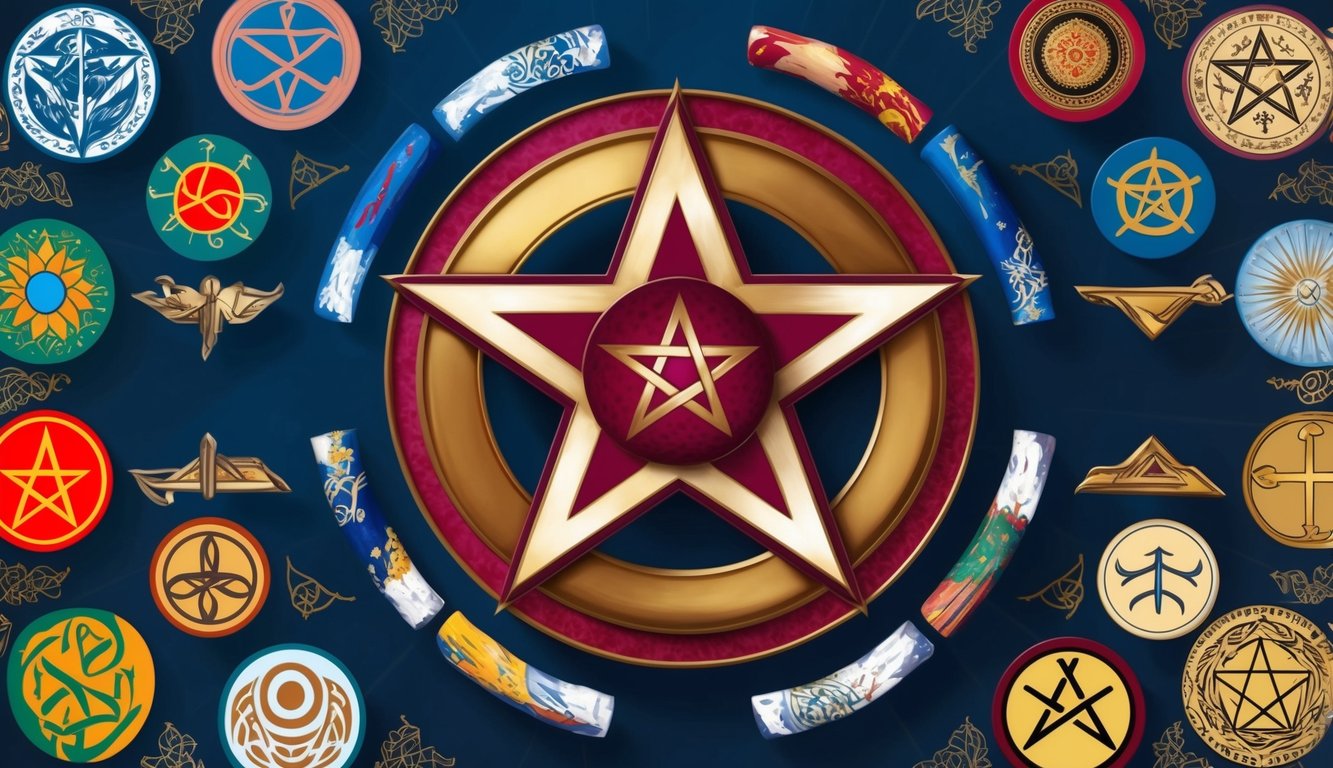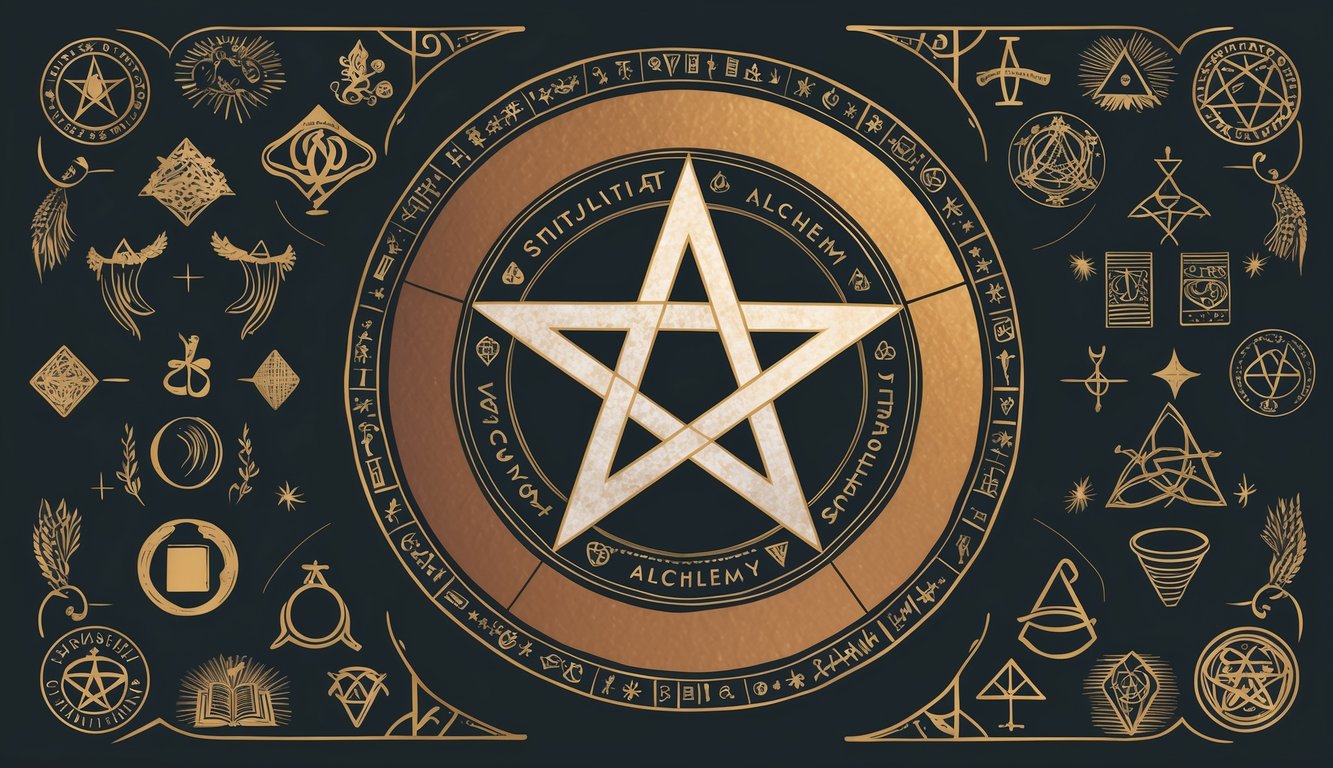Don’t Miss Out On This Unique Astrological Opportunity
Are you tired of spinning your wheels and getting nowhere? Simply put, you’re out of sync: you’re out of alignment with your astral configuration.
But: there’s a kind of map that can help you reclaim your alignment. Think of it as your own personal blueprint to success and happiness: a blueprint that will help you live your most amazing life.
Get started here.
The pentagram often sparks curiosity, symbolizing different things across various cultures and beliefs.
In Christianity, it might catch your attention as it is sometimes linked to the five wounds of Christ, which brings a deep spiritual meaning to the symbol.
The pentagram has been interpreted as a representation of Christ’s sacrifice and resurrection.
Understanding these connections might help you appreciate why the pentagram appears in Christian art and texts.
Its use can be both symbolic and historical, offering insights into how early Christians expressed their faith.
This meaning adds a fascinating layer to its presence in religious and historical contexts.
When you delve into the historical usage, you might be surprised to find how the pentagram has evolved.
It reflects a journey from ancient symbolism to a modern emblem within various Christian traditions.
As you explore, you’ll find rich stories and meanings that add depth to this intriguing symbol.
Historical Origins and Evolution
The pentagram has a rich history that spans various cultures and religious practices.
You will discover how this five-pointed star symbol developed from ancient civilizations and transformed within different belief systems.
Its significance changed dramatically over time, especially within Christianity.
Ancient Symbolism
In ancient times, the pentagram symbolized harmony and balance.
The earliest records trace back to Babylonia, where it was used to denote directions.
In ancient Greece, the Pythagoreans saw the pentagram as a symbol of mathematical perfection.
Hebrew letters also played a role in its structure, adding layers of spiritual meaning.
This star represented the five elements—earth, air, fire, water, and spirit.
Such associations made it a powerful symbol for many ancient peoples seeking unity and protection.
Adaptation Across Cultures
As it spread across cultures, the pentagram took on new meanings.
In the ancient world, it was used in Egyptian and Greek practices for its perceived mystical qualities.
The Pentagon in ancient geometry also reflects these shapes’ importance.
In some cultures, the pentagram became intertwined with the pentacle, often used in rituals and ceremonies.
Its use shifted slightly in each culture but generally maintained connections to spirituality and the elements.
Its adaptability kept it relevant through many cultural transitions and influences.
From Paganism to Christianity
The journey from paganism to Christianity marked a significant shift in the pentagram’s meaning.
Originally celebrated in pagan rituals, it represented protection.
It also appears in Arthurian literature, like in Sir Gawain and the Green Knight, symbolizing knighthood virtues.
Eventually, Christians adapted the star, associating it with the five wounds of Christ.
The pentagram became a pentangle, representing truth and holiness, and at times viewed with suspicion as beliefs shifted.
This transformation showcases its dynamic nature and enduring presence within spiritual narratives.
Over time, the symbol found a place in various religious and philosophical traditions, reflecting deeper spiritual meanings.
Its presence in Christian iconography highlights the evolving interpretations of faith and sacred geometry.
This aligns with 1 Corinthians timeless wisdom, emphasizing the ever-changing yet enduring nature of spiritual truths.
Mathematical and Geometric Significance
The pentagram is deeply tied to mathematical concepts like the golden ratio and appears prominently in architecture.
These connections highlight the balance and harmony in both math and design.
The Golden Ratio and Pythagoras
The golden ratio, often symbolized by the Greek letter phi (φ), is about balance and beauty.
When you study the pentagram, you will find this ratio everywhere.
This is due to the way its segments relate to each other.
In fact, each line within a pentagram divides the others in the golden ratio.
Pythagoras, a Greek philosopher who loved numbers, found the pentagram fascinating because it connected to this perfect proportion.
Ancient Greek thinkers believed this ratio symbolized perfection and harmony.
The golden ratio appears not only in the pentagram but also in nature and art across history.
Five-Pointed Shapes in Architecture
Pentagons and star pentagons find their place in various architectural wonders.
You might notice how structures like the Amiens Cathedral use these shapes.
They show off the precision and balance found in religious buildings.
Architects harness five-pointed shapes to create visually stunning designs.
A circle often surrounds the pentagram, symbolizing eternity and continuity, enhancing its meaning in Christian architecture.
This interaction between simple geometric shapes allows for breathtaking visuals and structural stability.
These symbols connect the divine with the mathematical world, showing you how numbers and faith beautifully intersect.
Through using these shapes, early builders invited the divine into spaces meant for worship, underlining the sacredness of their architecture.
Cultural and Religious Interpretations

The pentagram has been viewed differently in various religious and cultural contexts.
Some see it as a protective symbol, while others associate it with dark forces or spiritual ideas.
Let’s explore its diverse meanings across Christian, Neopagan, and Satanic beliefs.
Christian Symbolism
In Christianity, the pentagram has been used as a Christian symbol representing the five wounds of Christ.
During the Middle Ages, it was considered a sign of protection, often inscribed on buildings and church decorations.
Its five points were linked to the five senses and the five elements, though its meaning was primarily tied to the passion of Jesus.
The pentagram gradually lost favor as a Christian symbol due to complex theological interpretations and its association with other beliefs.
Despite its historical significance, you might rarely see it in modern Christian contexts today.
Still, understanding its past can enrich your view of how symbols evolve across time and faiths.
Neopagan and Wiccan Beliefs
In Neopagan and Wiccan traditions, the pentagram, often within a circle called a pentacle, represents the five elements: earth, air, fire, water, and spirit.
It symbolizes harmony and the interconnectedness of all life.
For Wiccans, the pentacle is a sacred symbol used in rituals to honor the Triple Goddess and the Horned God.
It acts as a protective emblem against evil and is a representation of power and faith.
If you practice Wicca or are exploring Neopagan beliefs, the pentagram serves as a meaningful tool for spiritual growth and connection to the natural world.
Satanic Associations
The pentagram has a complex role in Satanic beliefs.
Inverting the pentagram symbolizes evil and chaos.
The Church of Satan adopts this interpretation, particularly the Sigil of Baphomet, which features a goat’s head within the inverted pentagram.
This association with Satanism and the occult led to widespread misconceptions, linking all pentagrams with negative meanings.
However, its use in modern Satanic practices is distinct from other spiritual traditions.
You might find this perspective unsettling or intriguing, depending on your viewpoint, but it’s crucial to recognize its role in the broader landscape of religious symbols.
Symbolism in Modern Contexts

The pentagram and pentacle carry various meanings today.
They appear in pop culture and media, and are used in religious and esoteric practices.
Each context gives these symbols unique interpretations.
Pop Culture and Media
In pop culture and media, the pentagram often appears with an edgy or mystical vibe.
It’s frequently shown in movies and shows dealing with magic or the occult.
This use can shape how people see it, sometimes associating it with evil or magic due to its dramatic portrayals.
Music videos and album covers often feature the pentagram as a symbol of rebellion or mystery.
In contrast, some video games use it as part of a magical system, giving it a fantasy twist.
This media exposure has made the pentagram widely recognized, though its meanings can vary widely.
Contemporary Religious and Esoteric Uses
In modern religious contexts, the pentagram is often a symbol of protection and spirituality.
Many neo-pagan groups, like Wiccans, use it to represent elements like earth, air, fire, water, and spirit.
This is typically done with the pentacle, which is a pentagram inside a circle.
In esoteric practices, the pentacle is part of many rituals and is said to ward off negative forces.
For these practitioners, it is more a tool for personal growth and insight rather than anything evil.
These uses highlight the pentagram’s positive aspects in a religious or spiritual setting, contrasting its sometimes dark portrayal in the media.
Applications and Practices

The pentagram has rich applications across various cultures and beliefs.
It is often used for protection and as a tool in rituals and ceremonies, particularly in magic and the occult.
Talismans and Amulets
You might find the pentagram used as a talisman or amulet, believed to offer protection.
This symbol is frequently incorporated into jewelry or keepsakes to guard against negative energies.
The five-pointed star has been associated with defense against evil and can be a central figure in safeguarding rituals.
The use of the pentagram as a protective charm is seen in numerous cultures, transcending religious beliefs.
In Wicca, for example, the pentagram is worn to create a protective circle, warding off harmful spirits.
Historical figures like Heinrich Cornelius Agrippa emphasized its role in protective spells.
Ritualistic Uses and Ceremonies
In the realm of rituals and ceremonies, the pentagram serves as a powerful symbol. People often use it in magic practices related to the occult and Wicca.
The pentagram can represent the five elements—earth, water, fire, air, and spirit, forming a balanced circle of life.
Some religious practices feature the pentagram in intricate ceremonies meant to draw on its symbolic powers.
For instance, the Sigil of Baphomet uses the pentagram to convey specific meanings within certain occult traditions.
Prominent figures like Éliphas Lévi have discussed how the pentagram can connect with spiritual realms, while some historical beliefs incorrectly linked it to devils.



